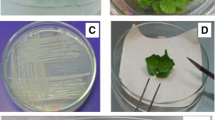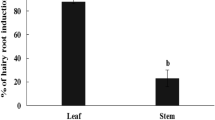Abstract
A hairy root culture system of Calotropis gigantea was established and effects of mechanical wounding (MW) and elicitors [methyl jasmonate (MJ), yeast extract (YE) and chitosan (CS)] on cardenolide production were investigated. All treatments stimulated the production of cardenolide in hairy root cultures of C. gigantea. CS was the most effective elicitor, followed by MJ. YE and MW also improved cardenolide yield in individual treatments. The highest cardenolide yield (1,050 ± 55 mg/l) was obtained after adding 50 mg CS/l for 20 days, which was 2.7-fold higher than the control.







Similar content being viewed by others
References
Anand CL, Stimson WH, Gray AI (2002) Pharmaceutical composition containing uscharidin or its analogues. US patent:6342490 b1
Cho HY, Rhee HS, Yoon SYH, Park J (2008) Differential induction of protein expression and benzophenanthridine alkaloid accumulation in Eschscholtzia californica suspension cultures by methyl jasmonate and yeast extract. J Microbiol Biotechnol 18:255–262
Datta S, De S (1986) Organ specific chemodifferentiation of cardenolides in Calotropis gigantea. Beitr Biol Pflanz 61:315–319
Datta S, Sibaprasad D (1986) Laticifer differentiation of Calotropis gigantea R. Br. ex Ait. in cultures. Ann Bot 57:403–406
Guillon S, Tremouillaux-Guiller J, Pati PK, Rideau M, Gantet P (2006) Hairy root research: recent scenario and exciting prospects. Curr Opin Plant Biol 9:341–346
Iriti M, Faoro F (2007) Review of innate and specific immunity in plants and animals. Mycopathologia 164:57–64
Kanojiya S, Madhusudanan K (2011) Rapid identification of calotropagenin glycosides using high‐performance liquid chromatography electrospray ionisation tandem mass spectrometry. Phytochem Anal. doi:10.1002/pca.1332
Kim Y, Wyslouzil BE, Weathers PJ (2002) Secondary metabolism of hairy root cultures in bioreactors. In Vitro Cell Dev Biol Plant 38:1–10
Kiuchi F, Fukao Y, Maruyama T, Obata T, Tanaka M, Saski T, Mikage M, Haque ME, Tsuda Y (1998) Cytotoxic principles of a Bangladeshi crude drug, akond mul (roots of Calotropis gigantea L.). Chem Pharm Bull 46:528–530
Lhinhatrakool T, Sutthivaiyakit S (2006) 19-Nor-and 18,20-epoxy-cardenolides from the leaves of Calotropis gigantea. J Nat Prod 69:1249–1251
Malcolm SB (1994) Milkweeds, monarch butterflies and the ecological significance of cardenolides. Chemoecology 5:101–117
Malcolm SB, Zalucki MP (1996) Milkweed latex and cardenolide induction may resolve the lethal plant defence paradox. Entomol Exp Appl 80:193–196
Newman RA, Yang P, Pawlus AD, Block KI (2008) Cardiac glycosides as novel cancer therapeutic agents. Mol Interv 8:36–49
Ono NN, Tian L (2011) The multiplicity of hairy root cultures: prolific possibilities. Plant Sci 180:439–446
Pari K, Rao P, Devakumar C, Rastogi J (1998) A novel insect antifeedant nonprotein amino acid from Calotropis gigantea. J Nat Prod 61:102–104
Pérez-Bermúdez P, García AA, Tuñón I, Gavidia I (2010) Digitalis purpurea P5bR2, encoding steroid 5β-reductase, is a novel defense-related gene involved in cardenolide biosynthesis. New Phytol 185:687–700
Prassas I, Diamandis EP (2008) Novel therapeutic applications of cardiac glycosides. Nat Rev Drug Discov 7:926–935
Rasmann S, Agrawal AA, Cook SC, Erwin AC (2009a) Cardenolides, induced responses, and interactions between above-and belowground herbivores of milkweed (Asclepias spp.). Ecology 90:2393–2404
Rasmann S, Johnson MD, Agrawal AA (2009b) Induced responses to herbivory and jasmonate in three milkweed species. J Chem Ecol 35:1326–1334
Roy AT, Koutoulis A, De DN (2000) Cell suspension culture and plant regeneration in the latex-producing plant, Calotropis gigantea (Linn.) R. Br Plant Cell Tiss Org Cult 63:15–22
Seeka C, Sutthivaiyakit S (2010) Cytotoxic cardenolides from the leaves of Calotropis gigantea. Chem Pharm Bull 58:725–728
Sharma M, Sharma A, Kumar A, Basu SK (2011) Enhancement of secondary metabolites in cultured plant cells through stress stimulus. Am J Plant Physiol 6:50–71
Udomsuk L, Jarukamjorn K, Tanaka H, Putalun W (2011) Improved isoflavonoid production in Pueraria candollei hairy root cultures using elicitation. Biotechnol Lett 33:1–6
Wang ZN, Wang MY, Mei WL, Han Z, Dai HF (2008) A new cytotoxic pregnanone from Calotropis gigantea. Molecules 13:3033–3039
Acknowledgments
This work was supported by the National High Technology Research and Development Program of China (2007AA021501).
Author information
Authors and Affiliations
Corresponding author
Rights and permissions
About this article
Cite this article
Sun, J., Xiao, J., Wang, X. et al. Improved cardenolide production in Calotropis gigantea hairy roots using mechanical wounding and elicitation. Biotechnol Lett 34, 563–569 (2012). https://doi.org/10.1007/s10529-011-0804-4
Received:
Accepted:
Published:
Issue Date:
DOI: https://doi.org/10.1007/s10529-011-0804-4




